Related Research Articles
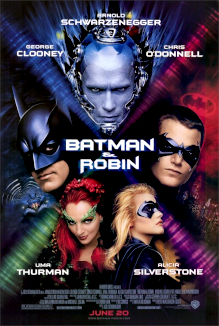
Batman & Robin is a 1997 American superhero film based on the DC Comics characters Batman and Robin by Bill Finger and Bob Kane. It is the fourth and final installment of Warner Bros.'s initial Batman film series, a sequel to Batman Forever and the only film in the series made without the involvement of Tim Burton in any capacity. Directed by Joel Schumacher and written by Akiva Goldsman, it stars George Clooney as Bruce Wayne / Batman, replacing Val Kilmer, Arnold Schwarzenegger as Victor Fries / Mr. Freeze, and Chris O'Donnell reprising his role as Dick Grayson / Robin, alongside Uma Thurman, Alicia Silverstone, Michael Gough, Pat Hingle, and Elle Macpherson. The film follows the titular characters as they attempt to prevent Mr. Freeze and Poison Ivy from taking over the world, while at the same time struggling to keep their partnership together.

Batman Forever is a 1995 American superhero film directed by Joel Schumacher and produced by Tim Burton, based on the DC Comics character Batman by Bob Kane and Bill Finger. The third installment of Warner Bros.' initial Batman film series, it is a stand-alone sequel to Batman Returns starring Val Kilmer, replacing Michael Keaton as Bruce Wayne / Batman, alongside Tommy Lee Jones, Jim Carrey, Nicole Kidman, Chris O'Donnell, Michael Gough, and Pat Hingle. The plot focuses on Batman trying to stop Two-Face and the Riddler in their scheme to extract information from all the minds in Gotham City while adopting an orphaned acrobat named Dick Grayson—who becomes his sidekick, Robin—and developing feelings for psychologist Dr. Chase Meridian.

Nelvana Enterprises, Inc. is a Canadian animation studio and entertainment company owned by Corus Entertainment. Founded in 1971 by Michael Hirsh, Patrick Loubert and Clive A. Smith, it was named after Nelvana of the Northern Lights, the first Canadian national superhero, who was created by Adrian Dingle. The company's production logo is a polar bear looking at Polaris, the North Star.
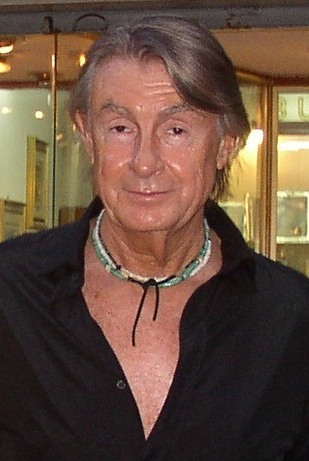
Joel T. Schumacher was an American film director, producer and screenwriter. Raised in New York City by his mother, Schumacher graduated from Parsons School of Design and originally became a fashion designer. He first entered filmmaking as a production and costume designer before gaining writing credits on Car Wash, Sparkle, and The Wiz.
Kenner Products, known simply as Kenner, was an American toy company founded in 1946. Throughout its history, the Kenner brand produced several highly recognizable toys and merchandise lines including action figures like the original series of Star Wars, Jurassic Park and Batman as well as die cast models. The company was closed by its corporate parent Hasbro in 2000.
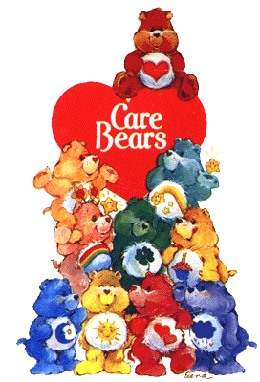
Care Bears are multi-colored bears, originally painted in 1981 by artist Elena Kucharik to be used on greeting cards from American Greetings. In 1983, the characters were turned into plush teddy bears.
Popples is a toy and television franchise created by Those Characters From Cleveland (TCFC), a subsidiary of American Greetings. Popples resemble brightly colored marsupial teddy bears with long tails ending in a pom-pom. Each Popple character transforms to resemble a brightly colored ball. In 2018, Popples was sold to Hasbro.

The Batmobile is the fictional car driven by the superhero Batman. Housed in the Batcave, which it accesses through a hidden entrance, the Batmobile is both a heavily armored tactical assault vehicle and a personalized custom-built pursuit and capture vehicle that is used by Batman in his fight against crime. Using the latest civilian performance technology, coupled with prototype military-grade hardware—most of which was developed by Wayne Enterprises—Batman creates an imposing hybrid monster car to prowl the streets of Gotham City.
Bernard Loomis was an American toy developer and marketer who introduced some of the world's most notable brands including Chatty Cathy, Barbie, Hot Wheels, Baby Alive, and Strawberry Shortcake, but perhaps his biggest marketing success was bringing a then-unknown film property called Star Wars to the toy shelves.

The World of Strawberry Shortcake is a 1980 animated television special written by Romeo Muller, directed by Charles Swenson, and produced by Swenson, Muller, and Fred Wolf. Starring the voices of Romeo Muller, Russi Taylor, Julie McWhirter, and Joan Gerber, it was made by Murakami-Wolf-Swenson in the United States in partnership with Toei Animation in Japan. The soundtrack was written and performed by Flo & Eddie of the rock group, The Turtles, for the opening theme of the series.
The fictional superhero Batman, who appears in American comic books published by DC Comics, has appeared in various films since his inception. Created by Bob Kane and Bill Finger, the character first starred in two serial films in the 1940s: Batman and Batman and Robin. The character also appeared in the 1966 film Batman, which was a feature film adaptation of the 1960s Batman TV series starring Adam West and Burt Ward, who also starred in the film. Toward the end of the 1980s, the Warner Bros. studio began producing a series of feature films starring Batman, beginning with the 1989 film Batman, directed by Tim Burton and starring Michael Keaton. Burton and Keaton returned for the 1992 sequel Batman Returns, and in 1995, Joel Schumacher directed Batman Forever with Val Kilmer as Batman. Schumacher also directed the 1997 sequel Batman & Robin, which starred George Clooney. Batman & Robin was poorly received by both critics and fans, leading to the cancellation of Batman Unchained.

The Batman OnStar commercials were a series of six television commercials featuring comic book superhero Batman, created by ad-agency Campbell-Ewald and based on the Tim Burton/Joel Schumacher Batman film series, airing from 2000 to the beginning of 2002. The commercials promoted the use of the automobile onboard guiding system OnStar. The commercials were successful, leading to a large increase in subscribers and a higher rate of subscriber renewals.
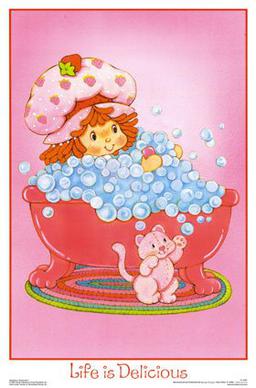
Strawberry Shortcake is a cartoon character used in greeting cards published by American Greetings. The line was later expanded to include dolls, posters, and other products featuring the character and an extended cast of friends and pets. In addition, the franchise has spawned television specials, animated television series and films. The franchise is currently owned by the Canadian children's television company WildBrain and American brand management company Iconix Brand Group through the holding company Shortcake IP Holdings LLC.
Jack Chojnacki served as the co-president of Those Characters from Cleveland Inc., a division of U.S. greeting card company American Greetings (AGC), in the 1980s. He assisted in the creation of several AGC franchises, including Strawberry Shortcake and the Care Bears.

Those Characters from Cleveland, LLC, officially trading as Cloudco Entertainment and formerly AG Properties and American Greetings Entertainment, is an American company which formerly traded as American Greetings' former character brand division. Properties owned by the company include Care Bears, Holly Hobbie, Madballs, Buddy Thunderstruck, Tinpo, The Get Along Gang and Boy Girl Dog Cat Mouse Cheese.
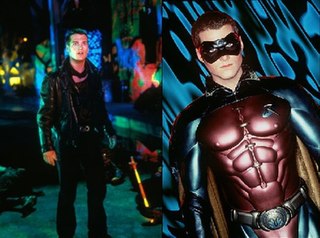
Dick Grayson, better known by his superhero alias Robin, is a fictional character from Joel Schumacher's superhero films Batman Forever (1995) and Batman & Robin, portrayed by Chris O'Donnell, based on the DC Comics character Robin, created by Bob Kane, Bill Finger, and Jerry Robinson.

Discovery Family is an American cable television channel co-owned by Warner Bros. Discovery and Hasbro Entertainment.
References
- ↑ "Toyetic". Dictionary.com. Random House. Retrieved March 13, 2015.
- ↑ McCombs, Phil (1977-12-24). "To an extent, the American toy business is recession proof". Public Opinion. p. 19. Retrieved 2022-10-07.
- ↑ Salmans, Sandra (February 14, 1985). "NEW YORKERS & CO.; A GROWN-UP'S WINNING TOUCH IN TOYS (USUALLY)". The New York Times . Retrieved March 8, 2015.
- ↑ Williams, Christina L. (2006). Inside Toyland: Working, Shopping, and Social Inequality. University of California Press. p. 40. ISBN 0520939492.
- ↑ Nussbaum, Emily (February 13, 2012). "It's Good Enough for Me". The New Yorker . Retrieved March 8, 2015.
- 1 2 Greenberg, James (2005-05-08). "Rescuing Batman". Los Angeles Times. p. E-10. Archived from the original on 2008-12-02. Retrieved 2019-05-11.
- ↑ Brooks, Xan (14 November 2000). "Second Coming". The Guardian UK. Retrieved 18 March 2015.
- ↑ The DVD commentary and the documentary Shadows of the Bat: Batman Unbound (on disc 2 of the Batman & Robin: Special Edition DVD set)
- ↑ Pollock, Dale, Skywalking: The Life and Films of George Lucas, Harmony Books, New York, 1983, ISBN 0-517-54677-9.
- ↑ Barnes, Brooks (30 September 2012). "Half-Shell Heroes Return to Action". New York Times . Retrieved 15 June 2015.
- ↑ Schuker, Lauren A. E. (9 November 2009). "The Cry Goes Out in Hollywood: 'Get Me Mr. Potato Head's Agent!'". The Wall Street Journal . Retrieved 15 June 2015.
Citations
- Fleming, Dan (1996), Powerplay: Toys as Popular Culture , Manchester University Press, ISBN 978-0-7190-4717-6